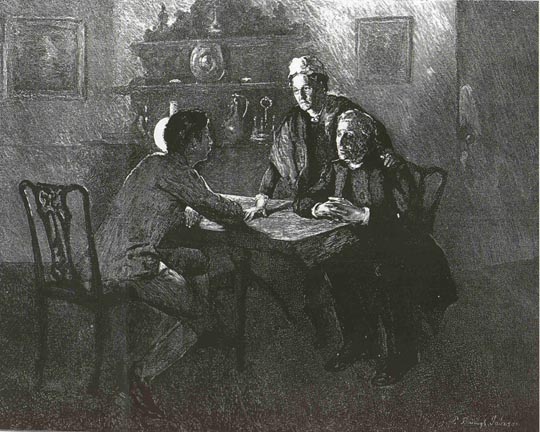
"Is she of a family such as you would care to marry into — a lady, in short?" asked his startled mother [Angel consults his parents about marrying Tess.] by Ernest Borough Johnson. Whole-page, horizontal: 22.7 cm high by 30.4 cm wide (9 inches by 12 ⅜ inches wide), framed, p. 301; n. b. Book Third, Ch. XXIV begins over the page, on p. 302, mid-column 3 (half-way through Ch. XXV, which ends on p. 303, at the bottom of column 1. Plate 10 from the illustrated serialisation of Thomas Hardy's Tess of the Durbervilles in the London Graphic (12 September 1891). For commentarries on the earlier illustrations, by different artists, please see the complete list.
Passage Realized: The Virtues of Mercy Chant against those of Tess Durbeyfield
His father persisted in his conviction that a knowledge of a farmer’s wife’s duties came second to a Pauline view of humanity; and the impulsive Angel, wishing to honour his father’s feelings and to advance the cause of his heart at the same time, grew specious. He said that fate or Providence had thrown in his way a woman who possessed every qualification to be the helpmate of an agriculturist, and was decidedly of a serious turn of mind. He would not say whether or not she had attached herself to the sound Low Church School of his father; but she would probably be open to conviction on that point; she was a regular church-goer of simple faith; honest-hearted, receptive, intelligent, graceful to a degree, chaste as a vestal, and, in personal appearance, exceptionally beautiful.
“Is she of a family such as you would care to marry into — a lady, in short?” asked his startled mother, who had come softly into the study during the conversation.
“She is not what in common parlance is called a lady,” said Angel, unflinchingly, “for she is a cottager’s daughter, as I am proud to say. But she is a lady, nevertheless — in feeling and nature.”
“Mercy Chant is of a very good family.”
“Pooh! — what’s the advantage of that, mother?” said Angel quickly. “How is family to avail the wife of a man who has to rough it as I have, and shall have to do?” [Book Third, "The Rally," Chapter XXIV, 302; in the 1897 volume edition, Phase the Fourth, "The Consequence," Chapter XXVI, 213]
Commentary: A Family Consultation about the Impending Marriage
Although his parents have always fancied that Angel would marry Mercy Chant, Angel argues that she is well suited to be a minister's rather than a farmer's wife. While the Reverend Mr. Clare ponders the notion that his son's wife should be a doctrinal match, so to speak, holding "a Pauline view of humanity" and "sound Low Church" principles, Angel insists that his helpmate must have a thorough comprehension of "the duties of farm life as well as a farmer himself." Surprisingly, perhaps, Mrs. Clare's chief concern is class as she harbours genteel notions associated with the term "lady." Thus, Hardy implies that she holds a degree of class consciousness ironic in the wife of an Anglican minister. The situational irony is not lost on the alert reader, for Tess Derbyfield is a direct descendant of the ancient D'Urbervilles (although Angel is unaware of her noble lineage at this point). To him she is the pastoral ideal incarnate.
The viewer observes the colloquy from Angel's side of the table. Borough Johnson focuses on the Clares' anxieties, rendering the details of the respectable parlour with deliberate vagueness, but we are aware of the middle-class trappings: the sideboard, its silverware, and flanking pictures, all intended to be suggestive of comparative affluence and respectability. Here, Johnson particularizes the elderly couple through details of facial expression, dress, and posture; a later illustration by Wehrschmidt, His father and mother were both in the drawing room, but neither of his brothers was now at home. Angel entered, and closed the door quietly behind him (24 October) realizes a far more awkward situation: Angel must broach to his dour parents the subject of his separation.
Scanned image and text by Philip V. Allingham/ You may use this image without prior permission for any scholarly or educational purpose as long as you (1) credit the person who scanned the image, and (2) link your document to this URL in a web document or cite the Victorian Web in a print one.
Bibliography
Allingham, Philip V. "The Original Illustrations for Hardy's Tess of the D'Urbervilles Drawn by Daniel A. Wehrschmidt, Ernest Borough-Johnson, and Joseph Sydall for the Graphic (1891)." The Thomas Hardy Year Book, No. 24 (1997): 3-50.
Allingham, Philip V. "Six Original Illustrations for Hardy's Tess of the D'Urbervilles Drawn by Sir Hubert Von Herkomer for the Graphic (1891)." The Thomas Hardy Journal, Vol. X, No. 1 (February 1994): 52-70.
Hardy, Thomas. Tess of the D'Urbervilles in the Graphic, 1891, 4 July-26 December, pp. 11-761.
Hardy, Thomas. Tess of the D'Urbervilles: A Pure Woman. Vol. I. The Wessex Novels.London: Osgood, McIlvaine, 1897.
Jackson, Arlene M. Illustration and the Novels of Thomas Hardy. Totowa, NJ: Rowman and Littlefield, 1981.
Vann, J. Don. "Tess of the D'Urbervilles in the Graphic, 4 July — 26 December 1891." Victorian Novels in Serial. New York: MLA, 1985, pp. 88-89.
Created 21 January 2001
Last modified 6 May 2024